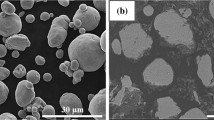Abstract
When a crack is formed on a fibre surface by the premature fracture of the coating, crack extension into the fibre or interfacial debonding between fibre and coating occurs, affecting the strength of the coated fibre. In the present work, the influence of pre-existent crack in double and gradient coating layers on the crack extension and interfacial debonding was studied to find the condition to improve the strength of the coated fibre. It is shown that, in both types of coating, (i) the energy release rates for crack extension into the fibre and for interfacial debonding become low when the inner coating portion adjacent to the fibre has low Young’s modulus, while they become high when the inner portion has a high Young’s modulus, and (ii) the ratio of the energy release rate for debonding to that for crack extension into the fibre is approximately 0.3. These results suggest that the reduced fibre strength by crack extension into the fibre in the case of strong interfacial bonding can be raised by double and gradient coatings with reduced Young’s modulus of the inner coating portion. Alternatively it can be increased by weakening the interface so that the critical energy release rate for debonding is less than 0.3 times the critical energy release rate for crack extension into the fibre.
Similar content being viewed by others
References
A. G. Metcalfe and M. J. Klein, “Interface in metal matrix composites” (Academic Press, New York, 1974) p. 125.
J. A. Dicarlo, “Proceedings Mechanical behaviour of metal/matrix composites” (AIME, Pennsylvania, 1983) p. 1.
S. Ochiai, “Mechanical properties of metallic composites” (Marcel Dekker Inc., New York, 1993) p. 473.
S. Ochiai and M. Hojo, Composite Interfaces 2 (1994) 365.
K. Honjo and A. Shindo, J. Mater. Sci. 21 (1986) 1879.
D. D. Himbeault, R. A. Varin and K. Piekarski, ibid. 24 (1989) 2746.
Idem., Metall Trans. A 20A (1988) 165.
S. Ochiai, S. Urakawa, K. ameyama and Y. Murakami, ibid. 11A (1980) 525.
Y. Murakami, K. Nakao, A. Shindo, K. Honjo and S. Ochiai, in Proceedings of the International Symposium on Composite Materials and Structures, Beijing, China, June (1986) p. 1045.
A. G. Evans, Mater. Sci. Engng A107 (1989) 227.
P. G. Charalambides and A. G. Evans, J. Amer. Ceram. Soc. 72 (1989) 746.
A. G. Evans, M. Y. He and J. W. Hutchinson, ibid. 72 (1989) 2300.
S. Ochiai, K. Osamura and K. Honjo, Mater. Sci. Engng A154 (1992) 149.
S. Ochiai and M. Hojo, Mater. Trans., JIM 34 (1993) 563.
S. Ochiai and K. Osamura, Z. Metallkde 84 (1993) 690.
Author information
Authors and Affiliations
Rights and permissions
About this article
Cite this article
Ochiai, S., Hojo, M. Effects of pre-existent crack in double and gradient coatings on the crack extension into fibre and interfacial debonding. Journal of Materials Science 33, 347–355 (1998). https://doi.org/10.1023/A:1004363611865
Issue Date:
DOI: https://doi.org/10.1023/A:1004363611865




